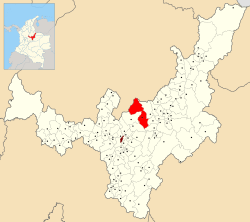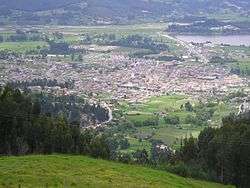Paipa
| Paipa | |||
|---|---|---|---|
| Municipality and town | |||
|
View of Paipa | |||
| |||
 Location of the municipality and town of Paipa in the Boyacá department of Colombia | |||
| Coordinates: 05°50′N 73°09′W / 5.833°N 73.150°W | |||
| Country |
| ||
| Department | Boyacá Department | ||
| Province | Tundama Province | ||
| Founded | 19 February 1602 | ||
| Founded by | Luís Enríquez | ||
| Government | |||
| • Mayor |
Yamid Noé Hurtado (2016–2019) | ||
| Area | |||
| • Municipality and town | 305.924 km2 (118.118 sq mi) | ||
| • Urban | 33.2020 km2 (12.8194 sq mi) | ||
| Elevation | 2,525 m (8,284 ft) | ||
| Population (2015) | |||
| • Municipality and town | 30,740 | ||
| • Density | 100/km2 (260/sq mi) | ||
| • Urban | 18,950 | ||
| Time zone | Colombia Standard Time (UTC-5) | ||
| Website | Official website | ||
Paipa is a town and municipality in the Tundama Province, part of the Colombian department of Boyacá. Paipa borders Duitama, Firavitoba, Tibasosa, Sotaquirá and Tuta.[1]
Geography
Paipa is located 15 km west of Duitama and 48 kilometres (30 mi) to the northeast of department capital Tunja. It is considered to be the main tourist center of the region, with a number of large hotels and hot springs. At an elevation of 2525 m, the climate is mild with an average of 14° Celsius.
Climate
| | ||||||||||||||||||||||||||||||||||||||||||||||||||||||||||||
|---|---|---|---|---|---|---|---|---|---|---|---|---|---|---|---|---|---|---|---|---|---|---|---|---|---|---|---|---|---|---|---|---|---|---|---|---|---|---|---|---|---|---|---|---|---|---|---|---|---|---|---|---|---|---|---|---|---|---|---|---|
| Climate chart (explanation) | ||||||||||||||||||||||||||||||||||||||||||||||||||||||||||||
| ||||||||||||||||||||||||||||||||||||||||||||||||||||||||||||
| ||||||||||||||||||||||||||||||||||||||||||||||||||||||||||||
Etymology
Paipa is named after the cacique of the Paipa people.[2]
History
Paipa was before the Spanish conquest of the 1530s inhabited by the Muisca. Their loose Muisca Confederation was composed of different rulers and the cacique of Paipa was loyal to the Tundama of Tundama. In its search for the Sun Temple, conquistador Gonzalo Jiménez de Quesada visited Paipa in 1539.[1]
Modern Paipa was founded on February 19, 1602, by Luís Enríquez. In 1755 he rose to the rank of Paipa corregimiento.[1]
The first building was built the same year was the church in clay tile, walls, stone foundations, walls in a plant 30 yards long and 11 wide, in the same place where the cathedral stands today. It was a figure that could act as police and criminal justice meant the actual tax collections in your jurisdiction, and other surrounding villages. On November 4, 1755, he was named Don Ignacio de Caicedo as first Corregidor of Paipa. In 1758 appointed Juan Avellaneda, Miguel Rodriguez and Esteban Lara as the first mayor of Paipa. In 1778, for the first time was to demarcate the boundaries of the municipality of Paipa, then guards Bonza, Paipa and Sativa. As the first event that led to Paipa "Tourist City", is the arrival of the first specialists in 1825 to undertake an analysis of the composition of the saline water of Paipa. But it was in 1852 when the central government began to take an interest in natural resources and sends a geographic committee headed by General Agustín Codazzi.
The construction of the current Central Church (now cathedral) Jaime Rook in the park began in 1906 and completed in 1920. In late 1930 and early 1931 arrived in Bogota the first passenger train. With the knowledge of their natural wealth termominerales water, municipal swimming pools were built in 1938 by launching the conformation of its resort in 1955 that is reinforced by the construction of Lake Sochagota. Departmental Assembly declared in 1960 as a Paipa city "tourist capital." The construction of the thermoelectric in 1953, generating population movements elsewhere in the country since 1964 Paipa presents a scattered and chaotic urban growth by the growth of its unusual population. It is at that moment when Paipa begins to lose the harmony of the urban design and architectural historical values. The context of the homogeneous main square is broken to make way for buildings "modern" that make Paipa begin to lose those elements of identity as a colonial city.
The celebration of 150 years of the Independence of Colombia in 1969 marks a pattern within the urban context of Paipa. The facades are unified in their white walls and green windows, doors and balconies that are usually kept painted pink so far. Inauguration of the monument to the community in the Pantano de Vargas, and now forgotten monument to Innocent Chincá on North Central Avenue, giving it the same name to the road on their way through the urban area of the municipality. They also inaugurated the extension of "the sixth" from the point of light until the pool with the name of Juan José Rondón. It is in this decade when it begins to develop the hospitality industry around the lake with his first Sochagota Springs Hotel or Colonial. Prior to these buildings and construction of municipal swimming pools, residents and tourists to bathe in hot springs and wells existed only Victoria hotel located within the urban area. In 1973 began the first Department of Bands and in 1975, extending its coverage and officially the first National Band Contest, an event that has since characterized Paipa in this genre. These events led to the construction of new urban public venues such as sports and cultural complex Concha Acústica "Valentín Garcia" built in 1990.
By 1995, both in Paipa, like in other neighboring cities and nationwide in general, began a dense urban Fulminans due to problems of public policy that makes Colombia a transformation from rural to urban areas in a very short time. The rural population began to seek refuge in stocks that apparently did not affect this problem or at least not to the same intensity. In response to these events is beginning to generate social housing developments to the north side and self-construction, and urbanization Forest.
Economy
Main economical activities of Paipa are tourism (the hot springs), agriculture (oat, barley, maize, wheat, potatoes) and livestock and dairy farming.[1]
Tourism
Among the places of interest are; Lake Sochagota, Ranchería nature reserve, the Vargas swamp, the church, the Casona del Salitre and Jaime Rook park. The latter is named in honor of James Rooke.
Lake Sochagota
Lake Sochagota is a very popular location for Colombians and has started to become known by foreign visitors. Activities include water-skiing, kayaking, as well as running and cycling around its edge.
Vargas Swamp
This is the location of the famous Vargas Swamp Battle which took place on the 25th of July 1819 and was decisive in the fight for independence. The battle is commemorated by a monument to the 14 lancers, and is the work of Rodrigo Arenas Betancur.
Paipa thermal baths
The thermal bath area covers approximately 5 hectares and includes a number of pools, both public and private as well as hotels, sports facilities, shops and cafes. The water comes from a subterranean lake whose waters come to the surface in this area where they are distributed by pipes to various establishments in the sector.
Casona del Salitre
Just outside the town is the Casona de Salitre, a beautifully restored colonial hacienda, which is a national monument as well as a hotel.
Born in Paipa
- Ángel Camargo, former professional cyclist
- Fernando Camargo, professional cyclist
- Wilson Cepeda, professional cyclist
- Flober Peña, former professional cyclist
Gallery

 Church of Paipa
Church of Paipa- Vargas Swamp
- Statue at the cemetery of Paipa
- Thermal baths
References
- 1 2 3 4 (Spanish) Official website Paipa
- ↑ (Spanish) Etymology Paipa – Excelsio.net
| Wikimedia Commons has media related to Paipa. |


